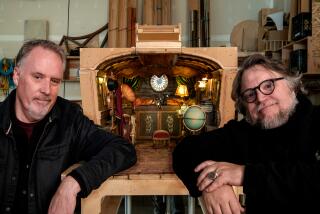A New Look for ‘Bug’
- Share via
History was made this week with the release of the video and DVD of Walt Disney and Pixar Animation Studio’s computer-animated hit, “A Bug’s Life” ($27 for VHS; $35 for DVD).
“A Bug’s Life” is the first film to be digitally transferred directly from the original computer imagery rather than the standard film-to-tape process. The digital format allowed the filmmakers to reframe the CinemaScope movie to fit the dimensions of the television screen. The video and DVD are also available in the wide-screen format, with letterboxing.
The comedy follows the adventures of an ant colony that yearly must give a lion’s share of its harvest to a group of greedy grasshoppers. Dave Foley, Kevin Spacey and Julia Louis-Dreyfus are among the voice talent; Randy Newman composed the Oscar-nominated score.
“The video is so remarkable,” says Thomas Schumacher, president of Walt Disney Feature Animation and Walt Disney Theatrical Productions. “The DVD is unbelievable.”
Even before work began on “A Bug’s Life,” says Schumacher, “we put resources aside so when we finished the movie for its theatrical release, we could go back in and get it right for the video.”
“A Bug’s Life” director John Lasseter spearheaded the technical advances for the video and DVD releases.
“It goes back to ‘Toy Story,’ ” says Lasseter, who directed that 1995 animated hit. “It was [Pixar’s] first movie and a real learning experience. When ‘Toy Story’ went to video, it sold tons of cassettes. [On video] it really starts to become part of the fabric of the society more than when it is in the movie theater because of the repetition of it and the opportunity for people who don’t normally go to see these movies in the theater.”
Adds Lasseter: “We make these movies for one reason only and that is to entertain audiences. My goal is to make the movie as good as it can be in whatever medium people will watch it in.”
Lasseter decided early into the planning of “A Bug’s Life” to shoot it in CinemaScope. But he realized there was a downside of the format--CinemaScope movies usually look awful on video because they need to be panned and scanned and cropped to fit a TV screen.
“We started thinking about our technology and said we could use our technology to reframe the movie,” he says.
“In our medium, you can go back and revisit the animation because it’s all saved in the computer. We decided that after we were done with the movie we would go back and look at every scene and decide where we could just crop the end and do a pan and scan.”
But for those scenes where too much of the frame was lost, Lasseter and his animators went back to the computer. If, for example, a scene had two ants talking to each other at either end of the frame, “we went back into the scene and moved them closer together and readjusted their eyes and recomputed the frame. Sometimes we wanted to maintain the edge [of the screen]--the side of the wide frame--so we just computed in what you weren’t seeing above and below the frame.”
If one compares the wide-screen version to the reformatted one, “they seem a little different,” says Lasseter. “But it’s ‘A Bug’s Life’ the way we want the audience to see it.”
After every scene was completed during production--and prior to it being sent off to the cameras to be put on film--Lasseter and his animators would save a copy on digital video. “So when it came time to do the video transfer, we just went back and remastered the movie from those digital originals,” he says. “The audiences at home are going to see what we saw in our computer monitor. It’s crisp and beautiful. It is a real pure version of our movie straight from our computers.”
The video and DVD also feature 21 “outtakes” that were shown in theaters during the film’s ending credits and Pixar’s “Gerri’s Game,” the 1997 Academy Award-winner for best animated short, which played with “A Bug’s Life.”
More to Read
Only good movies
Get the Indie Focus newsletter, Mark Olsen's weekly guide to the world of cinema.
You may occasionally receive promotional content from the Los Angeles Times.











